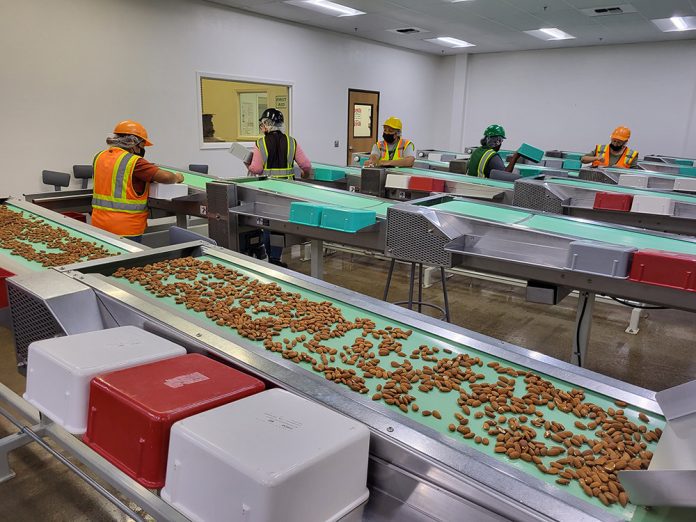Satellite imagery may capture LeGrand, Calif. as a small, monochromatic square in a patchwork of green and gold farmland.
But what high-tech eyes can’t see is this Central Valley town of 1,600 people is home to one of the largest almond businesses in the state.
Located 14 miles southeast of Merced, Minturn Nut Company handles more than 100 million pounds of almonds a year. Its facility spans more than 400,000 square feet under roof, with another 100,000 square feet covered by overhang.
The company processes and markets brown-skin and in-shell almonds for roughly 400 growers, sending their product to foreign customers that include China, India and Europe. A third of its volume is sold to U.S. buyers. Minturn Nut employs up to 160 employees for most of the year.
At the center of all this is Keith Rigg, Minturn Nut’s CEO since 2007. An almond industry veteran, he began his career in 1980 as a field representative for Blue Diamond Growers. In 1992, Rigg went to work as procurement manager for Chicago-based John B. Sanfilippo & Sons, a large, diversified nut company. Seven years later, he joined Minturn Nut. Since 2012, Rigg has also been its managing partner.
Here, he shares his thoughts on the almond price outlook, India’s tariffs and his opposition to the socially conscious demands of ESG policies.

Q. What’s your outlook for almond prices over the next year or two?
The last time we were met with these kinds of challenges was in the early 1980s, when we had similar issues: a stronger dollar, higher interest rates, inflation and so forth. But if you just look back to last November, December and January, our industry was breaking sales and shipping records per month. Then in February, when we started receiving all the rain and cold weather during bloom, we as an industry intentionally pulled off the market. Having the luxury of the rear-view mirror, that’s probably something we shouldn’t have done quite as severely as we did because it did stop our momentum.
Once we are again comfortable with the supply picture, our industry can get back into the mode where we accept the market for what it is, not that we’re going to lay down and accept any low price but have a clear focus on trying to get out from under the weight of our inventory. That truly needs to be our focus. What was promising in looking back at those three months when we were breaking records, most of the increased demand was coming from our emerging markets. One can say, ‘Yes, they’re price-sensitive and prices were cheap,’ but I’m encouraged we can get those markets rolling again. Our goal is to build inelastic demand in those newer markets.
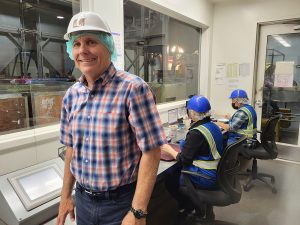
Q. India recently removed its retaliatory tariffs on U.S. almonds. What are your thoughts on that? And how long do you think it will take California to regain its market share there?
It’s not regaining it; it’s building it further. Even during the last few years when we had the retaliatory tariffs in place, we were still able to grow the market. Any tariff savings is good. We’ll take all we can. It amounts to about 3.3 cents a pound on in-shell sales. It’s about 11 cents a pound in savings to California or to India, depending on how you look at it, on the meat delivery.
Q. Well, that’s good, isn’t it?
Yes, every bit counts. We haven’t seen an administration willing to go to bat for trade, period. So, this is welcoming to our industry and encouraging to any other industries trying to negotiate on tariffs. On the other hand, we need to really fight for our industry to get our meat tariff brought down to in-shell parity. The tariff on meats is three times that of in-shell. Right now, we’re at a huge disadvantage to Australia. Their tariff is half of what our in-shell is. We’ve got both an arm and a leg tied behind our back trying to compete against that.
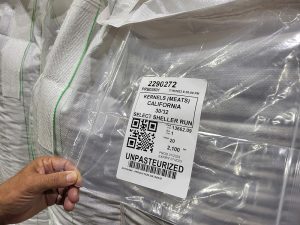
All the Indian buyers I deal with, and that’s a lot, agree with me. They’d love to see that tariff brought down because that would give them the ability to buy Butte/Padres and a lot of other varieties they’re basically shut out of the market on because the tariff is so high on meats. Not all varieties lend themselves to being a good candidate to do in-shell.
Q. What are the biggest challenges for you and your growers?
The No. 1 challenge right now is delivering a profit back to our growers. That’s the No. 1 reason we’re in business. At this point, our growers would appreciate any profit.
Another big challenge is the sustainability and ESG [environmental, social and governance] policies being forced down our throats from corporate buyers and the government. I am a little disappointed how some of our industry leaders are not only accepting these policies but embracing them. It’s time to push back. We are the definition of a healthy and sustainable crop. We don’t believe these policies create the added demand suggested. These policies are hollow, phony and can become a real obstacle that does nothing but add cost to our product. The standards are always changing and are extremely subjective. These ESG policies are a way for corporate America and government to work together and have more control over our industry and take people out of business. A true return to a free market would be a breath of fresh air.
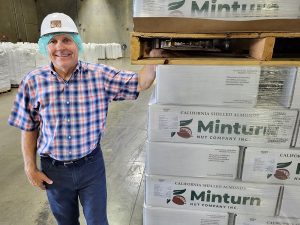
Our growing community is worn out over it, especially at these price points. A lot of growers are sick of the government getting further and further into our businesses. I feel the same way. I just see it as a detriment to the long-term health of our industry.
Q. What are one or two of the most important things Minturn Nut has done in the last few years?
We went through a major expansion in 2018. That has helped us handle these larger crops. We built a large, cement tilt-up warehouse. We purchased a lot of electronic sorting equipment and processing equipment to make us more efficient and able to handle the increased volume with the same amount of employees.
Over the years, we have tried to deliver straightforward communications along with timely, competitive returns to our growers. I have been fortunate to have solid, commonsense partners as well as stable, dedicated staff. It’s a combination of that and a growing industry that’s allowed us to become the company we are today.
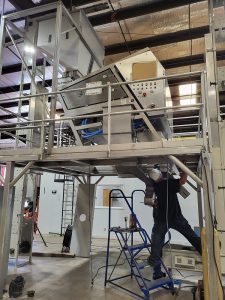
Q. Where is Minturn Nut headed?
I’m confident our industry is growing one of the best agricultural products on earth. Once we work through this oversupply and get COVID-19 further in the rearview mirror, we’re going to be a very healthy industry again. Our goal at Minturn Nut is to maintain and continue to grow our share of the industry’s volume in a measured fashion, all while delivering a profitable return to our valued growers.
At the same time, we are going through a deep valley. None of us is having too good of a time. We have inflation, eroding equity and demand that seems to be stagnant. Put that on top of increased regulatory policies and other issues that have many people in our industry doubting what the future looks like. We will get past this, and just like in the ‘80s, once we buoy through it, we’ll be better off having met the challenges. We’ll become more efficient, develop a better understanding of our markets and most likely see new product development along with other advancements. If every day was easy, you wouldn’t truly appreciate the good times when you have them. I have optimism for the future, and I think Minturn Nut is going to be a big part of it.







